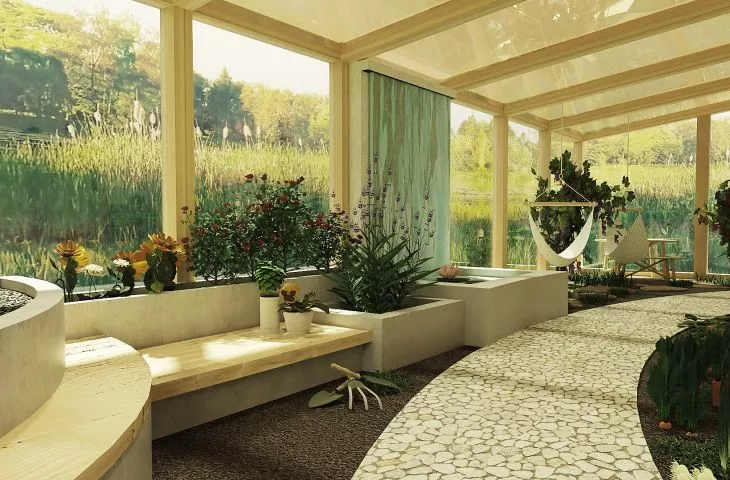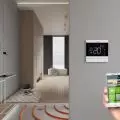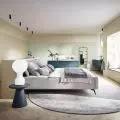3. analysis of polysensory stimulation
Senses
Juhani Pallasmaa in his book "Eyes of the Skin" addresses the role of the senses in perceiving architecture. She points out that good architecture should be multi-sensory, extending the real world and activating all sensory spheres.
Sense of sight
Pallasmaa states that noticeably in perceiving the world, sight is favored, with other senses often overlooked, but importantly, the eye cooperates with them to a great extent. With the help of sight, we sense heat or cold, mainly by seeing the colors of objects and the hue of light. With the help of sight, we understand what a person is feeling by looking at facial expressions.
Wladyslaw Strzeminski, in his book "The Theory of Sight," raises a point about sight: our eyesight does not have to be sharp as falcons to perceive something better, what is important is visual awareness, that is, the simultaneous use of our intellect.13 We often turn off our eyesight in order to feel something more. As Pallasmaa writes, in order for imagination to be activated, we need subdued light - marking the important role of shadow. He additionally points out that uniformly bright light is not conducive to a person whose eye is accustomed to perceiving twilight.14 Blind people, on the other hand, "see" with other senses, often it is thermal sensitivity in space, the temperature of objects they feel.15
sense of touch
The philosopher René Descartes, on a par with sight, credited touch, while pointing out that it is this sense that is less prone to error. With sight we often experience only vaguely, with touch - fully physically. We feel the warmth or coolness of objects, smooth, soft or porous and hard textures, evoking different states in us. Through touch we learn not only to recognize surfaces, the weight of materials, the state. Through the skin we have self-awareness of our own body. Touch is a dialogue, a way of communicating, often without the use of other senses. An example is touching the forehead to check the temperature.
sense of hearing
Hearing, also equals silence, because it is silence that is often salutary for us to focus on something else or relax. Sound affects our emotions. There are sounds that make us relax, de-stress, but also those that cause aggression, fear, anxiety, irritation...We also attribute certain sounds to a certain thing. In the modern world, we are often overtired precisely by sound, it comes to us too much, with different intensities. This depends primarily on the places where we stay. Acoustics can then be salutary for us.
sense of smell
Pallasmaa writes that we are capable of recognizing ten thousand different smells, so we can also remember. Often a smell reminds us of a place, a story, an object or a person, and evokes certain emotions. With the help of scents, the public is manipulated, as exemplified by the variety of services offered to encourage customers to buy them.16 Aromatherapy uses a variety of essential oils that act on humans in specific ways. Edward T.Hall, in the aforementioned book "The Hidden Dimension," criticizes the ignorance of the sense of smell by people. He argues that the blandness and profusion of various scents contributes to a lack of memory, since smell is something that retains our memories.
sense of taste
This sense can be stimulated using the sense of sight. The right images, have the effect of stimulating our taste buds. The sense of smell is also important here - after all, smell stimulates our taste buds. Deyan Sudjic, in his book "The Language of Things," writes about the influence of design on our senses and the effect of an object's form on our taste buds, for example. 17 It turns out that the color we see determines our sense of taste. This is the case with coffee, for example. Researchers from Oxford conducted an experiment showing that coffee in a blue mug is the sweetest, while the white color emphasizes the taste more and the coffee appears rather bitter.18
Kinesthetic sense - otherwise known as proprioception or kinaesthesia
It allows us to be aware of where our limbs are. This is made possible by proprioceptors located in tendons and muscles. Information about muscle tension reaches the brain and, without looking, I know where a part of our body is.19 Kinesthesia allows us to feel using our whole body. Kinesthetic space, which is the space that allows us to perceive with our body. Our body feels good in one, not necessarily in another. This is determined, for example, by a room that is too cramped or too large, but also by something that limits us in it, encloses us in some framework, does not allow us to relax.
Nowadays, too many stimuli reach us, this is related to the rapidly developing technological progress. We live in a world of virtual reality, which on the one hand gives us more opportunities, on the other hand there is an overstimulation of the senses, of which we often have no idea, living in a busy world, saturated with images, sounds...Pallasmaa also points out that today's world is highly technologized, which affects the feeling of alienation. This is the result of neglecting the role of the senses and the imbalance in our sensory system.20
the importance of color and light in therapy
Interior color plays an important role in how people function in space. Psychologists analyze this based on studies of human behavior. What will be the importance of color in therapy? Specialists in the snoezelen method say that the dominant interior color in such therapy should be white, but not pure white. Since it perfectly focuses the light and brings out its color, this can be crucial when the light in the Room is most important. White additionally makes even a small room, seem larger - this is important, because snoezelen rooms are by design small in size.
An interesting issue is the so-called chromotherapy, or color therapy - treatment with colors. Colors have a significant effect on us. It is not only the color of walls or objects, but also about the color of light. Colors can be divided into warm and cold, expressing different emotional states, moods...21 The color white is considered to bring peace, security, has a rather positive effect, if there is not too much of it. The ideal colors for relaxation are blue and green. In addition, they are also calming and soothing. Yellow reduces stress and fatigue, pink stimulates optimism and appetite. Violet relieves migraines and headaches. Black is used to treat neurosis.22 This is a general classification in color therapy.
Effects of colors in polysensory stimulation:
- blue, among others: used to treat hypertension, insomnia, headaches; calms, soothes
- green, among other things: aids heart function; relaxes and relaxes, reducing tension; adds calmness
- yellow, among other things: stimulates, activates and energizes; aids memory, treats anxiety, depression, stress and fatigue; can also have an over-stimulating effect
- orange, among other things, adds optimism, helps express emotions, stimulates appetite, relieves symptoms of epilepsy
- red, among other things, stimulates, strengthens, raises blood pressure; care must be taken because it can also irritate
- purple, among other things, cleanses, soothes and relieves stress; balances and calms; stimulates creativity and sensitivity; helps with anxiety, obsessions and trauma.23
It's hard to narrow down the color scheme of lighting in a snoezelen room to a single color, as it has multiple uses and implies both relaxation and activation. Hence, it is important to be able to adjust the color of the light and its intensity.Treatment with colors, of course, requires a lot of patience, since the effects are not immediately visible, it is also a complicated method.
furnishings - impact on stimuli
Furnishings can be any thing that complements the interior. Each person, in a different way, perceives the elements of furnishings, according to his preferences surrounds himself with objects that help him function, take care of his comfort and well-being. Form - our perception of the object - becomes an important priority. This is not just about aesthetics, but about the way a person perceives an object. Whether he is closer to round, organic shapes or perhaps angular, geometric shapes. Form can evoke different feelings in us. The texture, the material from which the item is made is also an important issue, as it affects our perception of the object. Touching on the aspect of designing therapy rooms, i.e. snoezelen, it is worth remembering that nothing should be accidental. Every object, element has a meaning and adds to the overall character of the interior. Without elements that interact with each other, there is no space whose task is to influence in the intended way. Elements, therefore, are a tool for therapy, not just so-called equipment that "looks nice" and performs some function. A person interacts with an object, begins to discover and perceive something new, "different". The object gives room to establish a dialogue.
music as a background for therapy
Music is very important for every person. It improves the mood, moves, calms or activates, adds energy, dictates the pace. Even a trivial, boring or monotonous activity becomes better when accompanied by music. In therapy rooms, i.e. the snoezelen room is equally important and largely determines the character of the interior, it becomes an element of therapy. Research at the University of Berlin focusing on the aspect of music in snoezelen is being conducted by composer Dr. Martin Buntrock, who dedicated his doctorate to this very subject.24 His compositions are used in snoezelen therapy. This is not easy, as the therapy focuses on different audiences with very different auditory sensitivities. Music therapy is worth mentioning here, in the case of snoezelen it is not just therapy with music or sound alone. As it is a polysensory room, it is only one element, stimulating primarily the sense of hearing. Music therapy enhances immunity, relieves various pains, has a wide range of applications, of course, properly selected.

















































